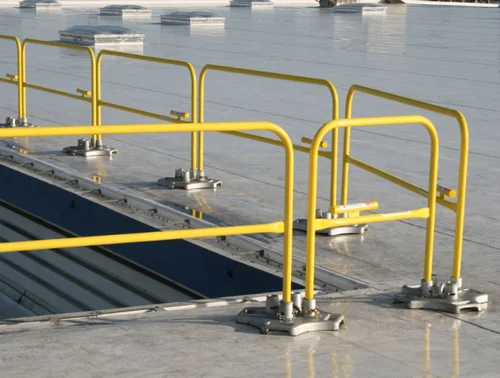Rooftop safety is a critical aspect of any construction or maintenance project. As workers often need to access rooftops for various tasks, ensuring their safety is paramount. One of the fundamental elements of rooftop safety is the installation of safety railings along the perimeter. In this guide, we’ll delve into the intricacies of rooftop safety railing perimeter planning to help you understand its importance and how to effectively implement it, including the utilization of temporary safety railing where necessary.
1. Introduction to Rooftop Safety Railing
Importance of Rooftop Safety
Rooftops pose significant risks to workers due to potential falls and accidents. Implementing proper safety measures, such as safety railings, can mitigate these risks and ensure a secure working environment.
Role of Safety Railings
Safety railings act as a physical barrier, preventing workers from accidentally falling off the rooftop perimeter. They provide a stable support system, allowing workers to move around safely while performing their tasks.
2. Understanding Rooftop Safety Railing Perimeter Planning
Definition and Purpose
Rooftop safety railing perimeter planning involves the strategic placement and installation of safety railings along the edges of a rooftop. Its primary purpose is to create a secure boundary that prevents falls and accidents.
Compliance with Safety Regulations
Rooftop safety railing perimeter planning must comply with relevant safety regulations and building codes. Adhering to these standards ensures that the installed railings meet the necessary safety requirements.
3. Factors to Consider in Rooftop Safety Railing Perimeter Planning
Roof Layout and Design
The layout and design of the rooftop influence the planning and installation of safety railings. Factors such as roof height, slope, and access points need to be taken into account to determine the optimal railing configuration.
Building Codes and Regulations
Familiarizing oneself with local building codes and safety regulations is essential for rooftop safety railing planning. These regulations stipulate requirements for railing height, material strength, and installation methods.
Type of Railing System
There are various types of safety railing systems available, including permanent, temporary, and portable options. Selecting the appropriate railing system depends on factors such as project duration, budget, and specific safety requirements.
4. Steps to Plan a Rooftop Safety Railing Perimeter
Site Assessment
Conduct a thorough assessment of the rooftop site to identify potential safety hazards and risks. This includes evaluating the terrain, existing structures, and access points.
Risk Assessment
Assess the potential risks associated with working on the rooftop, such as the likelihood of falls and the severity of potential injuries. Use this information to develop a comprehensive safety plan.
Design Considerations
Based on the site and risk assessments, develop a detailed design plan for the safety railing perimeter. Consider factors such as railing height, spacing, and anchoring methods to ensure optimal safety.
5. Installation Process of Rooftop Safety Railings
Preparation and Safety Measures
Before commencing installation, prepare the rooftop area and implement necessary safety measures. This may include providing personal protective equipment (PPE) to workers and securing the work area.
Installation Techniques
Follow manufacturer guidelines and industry best practices when installing safety railings. Ensure that the railings are securely anchored to the rooftop surface and properly aligned to provide maximum protection.
6. Maintenance and Inspection of Rooftop Safety Railings
Regular Inspection Schedules
Establish a regular inspection schedule to assess the condition of the safety railings. Inspections should be conducted by trained personnel to identify any signs of damage or wear.
Maintenance Procedures
Implement routine maintenance procedures to ensure the continued effectiveness of the safety railings. This may include cleaning, painting, and repairing damaged components as needed.
Importance of Upkeep
Maintaining the integrity of the safety railings is crucial for ongoing rooftop safety. Proper upkeep extends the lifespan of the railings and minimizes the risk of accidents due to structural failures.
7. Advantages of Proper Rooftop Safety Railing Planning
Enhanced Worker Safety
Properly planned and installed safety railings provide a secure working environment, reducing the risk of falls and injuries for workers.
Compliance with Regulations
Adhering to safety regulations and standards ensures legal compliance and protects against potential fines or penalties.
Prevention of Accidents
Effective rooftop safety railing perimeter planning significantly reduces the likelihood of accidents and injuries, enhancing overall workplace safety.
8. Conclusion
In conclusion, rooftop safety railing perimeter planning is essential for ensuring a secure working environment and preventing accidents. By considering factors such as roof layout, safety regulations, and maintenance procedures, construction and maintenance professionals can effectively implement safety railings to protect workers and comply with industry standards.




